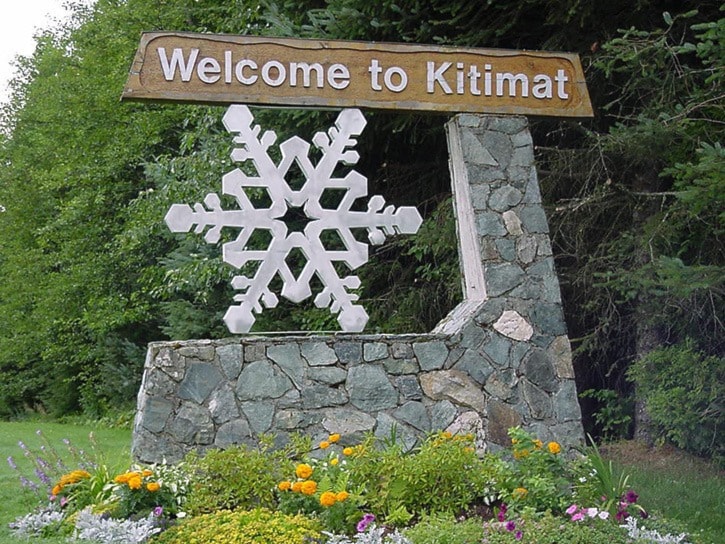“Kitamaat,” in Tsimshian, means “people of the snow.”
The name was given as a description of the Haisla residents of these lands at the northern end of Douglas Channel. Meteorologists would agree that Kitimat’s title is apt. But are we truly Snow Valley, and what about our weather statistics?
According to statistics from Environment Canada, the all-time Canadian record for snowfall in one day belongs to Lakelse B.C.
It was on February, 17, 1974 when an incredible 118 centimeters fell. Well, we are very close and prior to that record, the record was with Kitimat. On February 18, 1972 Kitimat’s Townsite Weather Station at the fire hall reported 112.3 cm of snow.
Talking about snow, in January of 1966 our same townsite weather station reported an incredible 436.9 cm. As for snowy years, the winter of 1971-72 takes the prize with a roof-breaking 1,054.9 cm. That’s over ten meters or about 33 feet.
The nearby Alcan station of West Tahtsa Lake also made it to the record books with impressive yearly totals.
Kitimat has had many amateur weather observers. Starting back in the early 1900s observations were taken at Kitamaat Mission by Reverend Raley and others. That station was operational until 1948. Official meteorological stations were established in the 1950s.
There have been weather stations at Alcan, The Public Safety Building, the Hatchery, and at the District of Kitimat’s Pollution Control Sewage Plant on the dyke road. We have even over the years had school weather stations which reported to the media province-wide. Today, most weather data is collected remotely with little human intervention. We rely heavily on the Terrace Airport Weather Station.
Kitimat has had meteorological observers, including Eileen Hutson. She has been able to get out, ruler in hand, to measure our big snowfalls. Recently, the winter of 2011-2012 was a whopper with 775 cm or about 28 feet. Had the snow continued into February and March, we would have been looking at a new record.
In the past, a lack of trained weather observers has limited accurate data received about snowfall events. Measurements at each of the stations vary. The Alcan station is wetter, and it measures less snow and less sun as reflected by its proximity to the mountains and its low elevation at just above sea level. The townsite station is drier, sunnier, and of course at 128 meters in elevation, it receives far more snow.
Environment Canada’s National Climate Archive site shows over a 30 year period from 1961 to 1990 Kitimat’s average annual snowfall was 494.8 cm. This compares to Calgary with 124 cm per year, and Montreal, considered a very snowy city with 218 cm. Communities do exist which do receive more snow than Kitimat but they are rare, and many of them are ski communities.
Our community stands out as an extremely snowy location which has serious implications. Living in Snow Valley means conforming to the strictest building codes in Canada, requiring us to live in homes rated with the strongest roofs designed in the whole country. It means getting used to fleets of snowblowers, keeping vehicles off the street during overnight snowfalls, it means paying huge municipal bills for snow removal which just may be the highest per capita in all of our country, and of course, it means life as usual, including going to work and school even with a metre of fresh snow. Clearly we have earned the title, “People of the Snow.” Appropriately, we have adopted the snowflake as an identifying icon.
Officially, Kitimat lies within the Humid Continental Climatic Zone. Our own local climate is characterized by large amounts of moisture and limited sunshine. Winters are relatively mild and summers can be rainy. The record low, recorded at least on four occasions, is minus 25 centigrade. Statistics show our annual precipitation; rain and snow combined is 239.5 cm. This compares to Vancouver Airport with 147.4 cm, and Victoria with 84.1 cm. Yes it is a lot, but be assured it is not a record.
Prince Rupert has, according to Environment Canada, an annual precipitation of 311.1 cm. Hartley Bay, our neighbour just south on Douglas Channel gets a yearly soaking of 454 cm. The Canadian record is at Henderson Lake on the Alberni Canal with an astounding 947 cm.
We live in a saturated location. Drainage is a big concern, requiring top-rate drainage systems. Floods are rare but, in the years prior to the Service Centre and Kildala Neighbourhood dykes, there were floods and evacuations from a rampaging Kitimat River. Fluctuations have even blown out bridges, like in 1978 when we lost the Wahtl Creek Bridge at Kitamaat Village. Flooding has periodically led to discoloured drinking water. We rarely have a shortage of moisture, but it can happen.
As for sunshine, our average annual hours are 1,405, compared to Victoria’s 2,193 and Calgary’s 2,405 hours. In other words, for every 24 hours of sun that Calgary gets, Kitimat would get 14.
Kitimat’s sunniest months are May and July. Don’t let anyone tell you Kitimat doesn’t get hot as its official warmest day ever was on July 29, 2009 when two of our weather stations both at the Hatchery and at Alcan registered a scorching 39.5 degrees.
People world-wide are obsessed with weather. No wonder the weather channel is so popular, and not surprisingly we in Kitimat are weather obsessed too. Many of us have pride in adversity; we identify with our extremes of weather. It is one of our identifying features and yes we have earned the title “People of the Snow,” or even perhaps people of the rain.
- Walter Thorne
